ContinuedSpode's formula for bone china produced a porcelain that was white, very translucent, and stable in the traditional Staffordshire firing process. Bone china, unlike true Chinese porcelain, used a sequence of biscuit then glost schedules and firing technologies similar to those of earthenware. In producing bone china, Spode did not have to re-train the factory's ovenmen or alter their schedules to accommodate this new ware. Within six years of introducing bone china Spode received a Royal visit. The Prince of Wales, accompanied by the Duke of Clarence, the Marquis of Stafford and others dignitaries, toured the Spode factory in September, 1806. Spode purportedly arranged his entire workforce at the factory in their best attire to greet the Royal party, “to manifest their respectful and loyal attachment to the Heir Apparent.” His Royal Highness must have been impressed. At the end of his tour, the Prince bestowed upon Spode the title “Potter and English Porcelain Manufacturer to His Royal Highness". Bat-printing on bone chinaOne of the most characteristic decorations on Spode bone china are the delicate, subtle grey prints applied over the glaze using the bat printing method. The small vignettes are produced from copper plates with stipple engraving. The small punched dots produce tones of light and shade depending on their density. The printer smears clear oil onto the copper plate, then presses a thin, flexible sheet of rubber-like animal glue called a "bat" onto the engraved design. The printer then presses the bat, covered with the oiled design, to the ceramic surface. The porcelain is then lightly dusted with powdered color which adheres only to the design of oily dots. After the printer carefully wipes away the excess color, the piece is fired slightly, which melts the glaze so that the print sinks into the glass coating.  
|
Spode Bone China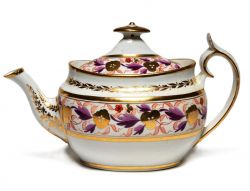
Teapot, painted pattern number 889, about 1810
The Potteries Museum & Art Gallery, Stoke-on-Trent | 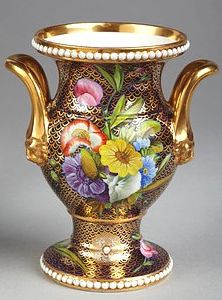
Vase with painted mark Spode and pattern number 1166, about 1810 © Victoria & Albert Museum, London |
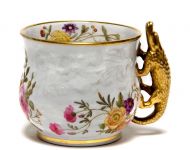
Floral embossed cabinet cup, painted mark Spode, about 1820.
The Potteries Museum & Art Gallery, Stoke-on-Trent | 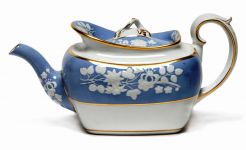
Floral embossed teapot painted mark SPODE and pattern number 2036, about 1820 The Potteries museum & Art Gallery, Stoke-on-Trent |
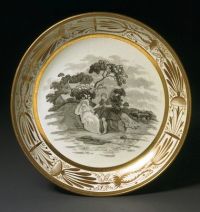
Spode, bone china, bat print pattern 558
© Victoria & Albert Museum, London | 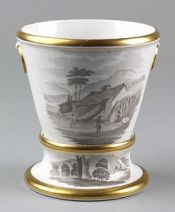
Spode bone china, bat print ed design
© Victoria & Albert Museum, London
|
|









